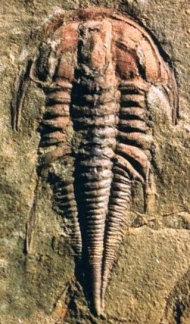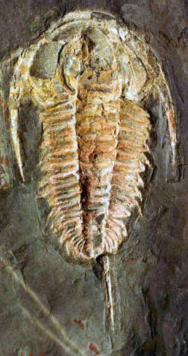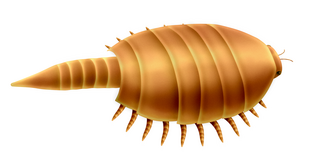
The Cambrian is the first geological period of the Paleozoic Era, and the Phanerozoic Eon. The Cambrian lasted 51.95 million years from the end of the preceding Ediacaran period 538.8 Ma to the beginning of the Ordovician Period 486.85 Ma.

Redlichiida is an order of trilobites, a group of extinct marine arthropods. Species assigned to the order Redlichiida are among the first trilobites to appear in the fossil record, about halfway during the Lower Cambrian. Due to the difficulty to relate sediments in different areas, there remains some discussion, but among the earliest are Fallotaspis, and Lemdadella, both belonging to this order. The first representatives of the orders Corynexochida and Ptychopariida also appear very early on and may prove to be even earlier than any redlichiid species. In terms of anatomical comparison, the earliest redlichiid species are probably ancestral to all other trilobite orders and share many primitive characters. The last redlichiid trilobites died out before the end of the Middle Cambrian.

Emuellidae are a small family of trilobites, a group of extinct marine arthropods, that lived during the late Lower Cambrian of the East Gondwana supercontinent, in what are today South-Australia and Antarctica.

Emuella is a genus of Cambrian trilobites of the family Emuellidae. Its fossils have been found in South Australia.

Redlichia takooensis is a species of redlichiid trilobite from the lower Cambrian-aged Emu Shale of Kangaroo Island, Australia.

Redlichiina is a suborder of the order Redlichiida of Trilobites. The suborder contains three superfamilies: Emuelloidea, Redlichioidea and Paradoxidoidea. These trilobites are some of the oldest trilobites known. They originated at the beginning of the Cambrian Period and disappeared at the end of the middle Cambrian.

Kootenia is a genus of trilobites of the family Dorypygidae. 118 specimens of Kootenia are known from the Greater Phyllopod bed, where they comprise 0.22% of the community. Its major characteristics are that of the closely related Olenoides, including medium size, a large glabella, and a medium-sized pygidium, but also a lack of the strong interpleural furrows on the pygidium that Olenoides has.

Redlichia is a genus of redlichiid trilobite in the family Redlichiidae, with large to very large species. Fossils of various species are found in Lower Cambrian (Toyonian)-aged marine strata from China, Korea, Pakistan, the Himalayas, Iran, Spain, southern Siberia, and Antarctica, and from Middle Cambrian (Ordian)-aged marine strata of Australia.

The Emu Bay Shale is a geological formation in Emu Bay, South Australia, containing a major Konservat-Lagerstätte. It is one of two in the world containing Redlichiidan trilobites. The Emu Bay Shale is dated as Cambrian Series 2, Stage 4, correlated with the upper Botomian Stage of the Lower Cambrian.

Anomalocaris is an extinct genus of radiodont, an order of early-diverging stem-group marine arthropods.

Naraoia is a genus of small to average size marine arthropods within the family Naraoiidae, that lived from the early Cambrian to the late Silurian period. The species are characterized by a large alimentary system and sideways oriented antennas.

Diplichnites are arthropod trackways with two parallel rows of blunt to elongate, closely spaced tracks oriented approximately perpendicularly to the mid-line of the trackway. The term is more often used for the ichnofossils of this description; however, similar trackways from recent arthropods are sometimes given this name as well.

Euthycarcinoidea are an enigmatic group of extinct, possibly amphibious arthropods that ranged from Cambrian to Triassic times. Fossils are known from Europe, North America, Argentina, Australia, and Antarctica.

Holyoakia is a genus of very small trilobites of the family Dorypygidae, from the late Lower Cambrian of South Australia and Antarctica.
Lemdadella is an extinct genus of redlichiid trilobites that lived during the late Atdabanian stage, which lasted from 521 to 514 million years ago during the early part of the Cambrian Period.
Paropsonema is an eldonioid known from the Devonian of upstate New York and the Silurian of southern Australia. It is the latest-surviving known member of the Eldonioidea and Cambroernida.

The Tonto Group is a name for an assemblage of related sedimentary strata, collectively known by geologists as a Group, that comprises the basal sequence Paleozoic strata exposed in the sides of the Grand Canyon. As currently defined, the Tonto groups consists of the Sixtymile Formation, Tapeats Sandstone, Bright Angel Shale, Muav Limestone, and Frenchman Mountain Dolostone. Historically, it included only the Tapeats Sandstone, Bright Angel Shale, and Muav Limestone. Because these units are defined by lithology and three of them interfinger and intergrade laterally, they lack the simple layer cake geology as they are typically portrayed as having and geological mapping of them is complicated.

The Muav Limestone is a Cambrian geologic formation within the 5-member Tonto Group. It is a thin-bedded, gray, medium to fine-grained, mottled dolomite; coarse- to medium-grained, grayish-white, sandy dolomite and grayish-white, mottled, fine-grained limestone. It also contains beds of shale and intraformational conglomerate. The beds of the Muav Limestone are either structureless or exhibit horizontally laminations and cross-stratification. The Muav Limestone forms cliffs or small ledges that weather a dark gray or rusty-orange color. These cliffs or small ledges directly overlie the sloping surfaces of the Bright Angel Shale. The thickness of this formation decreases eastward from 76 m (249 ft) in the western Grand Canyon to 14 m (46 ft) in the eastern Grand Canyon. To the west in southern Nevada, its thickness increases to 250 m (820 ft) in the Frenchman Mountain region.

The Bright Angel Shale is one of five geological formations that comprise the Cambrian Tonto Group. It and the other formations of the Tonto Group outcrop in the Grand Canyon, Arizona, and parts of northern Arizona, central Arizona, southeast California, southern Nevada, and southeast Utah. The Bright Angel Shale consists of locally fossiliferous, green and red-brown, micaceous, fissile shale (mudstone) and siltstone with local, thicker beds of brown to tan sandstone and limestone. It ranges in thickness from 57 to 450 ft. Typically, its thin-bedded shales and sandstones are interbedded in cm-scale cycles. They also exhibit abundant sedimentary structures that include current, oscillation, and interference ripples. The Bright Angel Shale also gradually grades downward into the underlying Tapeats Sandstone. It also complexly interfingers with the overlying Muav Limestone. These characters make the upper and lower contacts of the Bright Angel Shale often difficult to define. Typically, its thin-bedded shales and sandstones erode into green and red-brown slopes that rise from the Tonto Platform up to cliffs formed by limestones of the overlying Muav Limestone and dolomites of the Frenchman Mountain Dolostone.

Serrodiscus Richter and Richter 1941. is a genus of eodiscinid trilobite belonging to the family Weymouthiidae Kobayashi T. (1943), Order Agnostida. It lived during the late Lower Cambrian, with remains found in Canada, China (Gansu), The United Kingdom (England), Germany (Silesia), Poland, the Russian Federation, and the United States. It is named for the spines on the ventral side of the pygidium, which give it a serrated impression.
















